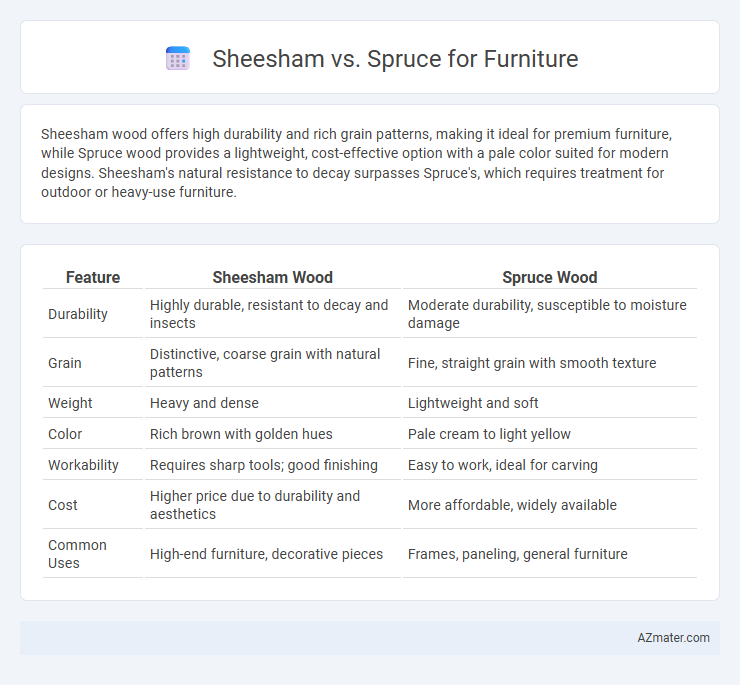Sheesham wood offers high durability and rich grain patterns, making it ideal for premium furniture, while Spruce wood provides a lightweight, cost-effective option with a pale color suited for modern designs. Sheesham's natural resistance to decay surpasses Spruce's, which requires treatment for outdoor or heavy-use furniture.
Table of Comparison
| Feature | Sheesham Wood | Spruce Wood |
|---|---|---|
| Durability | Highly durable, resistant to decay and insects | Moderate durability, susceptible to moisture damage |
| Grain | Distinctive, coarse grain with natural patterns | Fine, straight grain with smooth texture |
| Weight | Heavy and dense | Lightweight and soft |
| Color | Rich brown with golden hues | Pale cream to light yellow |
| Workability | Requires sharp tools; good finishing | Easy to work, ideal for carving |
| Cost | Higher price due to durability and aesthetics | More affordable, widely available |
| Common Uses | High-end furniture, decorative pieces | Frames, paneling, general furniture |
Introduction: Sheesham vs Spruce Furniture
Sheesham and spruce are popular choices for furniture, each offering unique characteristics ideal for different styles and uses. Sheesham wood, known for its rich grain patterns and durability, provides a luxurious, long-lasting option often favored for intricate designs and heavy-duty furniture. Spruce, lighter and more affordable, excels in lightweight furniture and modern minimalist styles due to its pale color and ease of handling.
Wood Origin and Botanical Profile
Sheesham wood, also known as Indian Rosewood, originates from the Dalbergia genus native to the Indian subcontinent and is renowned for its rich, dark grain and high durability. Spruce wood comes from the Picea genus, primarily found in boreal and temperate regions across the Northern Hemisphere, featuring a light color, straight grain, and softer texture compared to Sheesham. Both woods differ significantly in botanical profile and origin, influencing their uses in furniture, with Sheesham prized for heavy, intricate carvings and Spruce favored for lightweight, structural designs.
Appearance and Grain Patterns
Sheesham wood features rich, dark brown tones with contrasting golden streaks, creating a visually striking appearance ideal for elegant, traditional furniture. Its grain pattern is typically varied and intricate, showcasing swirling and wavy lines that add texture and character to pieces. Spruce, on the other hand, presents a light, creamy color with subtle, straight grain patterns that offer a clean, minimalist look suitable for modern furniture designs.
Strength and Durability Comparison
Sheesham wood, also known as Indian rosewood, offers exceptional density and hardness, resulting in superior strength and long-lasting durability that resists wear and termite damage. Spruce, a softwood, is lighter and less dense, making it more prone to dents and scratches, which reduces its durability compared to Sheesham. For robust, heavy-use furniture, Sheesham's strength and natural oils provide better longevity and structural integrity over Spruce.
Workability and Craftsmanship
Sheesham wood offers excellent workability with its natural oils enhancing durability and smooth finishes, making it ideal for intricate craftsmanship and detailed carvings in furniture. Spruce, lighter and softer, allows for easier shaping and sanding but may require more protective treatments to prevent damage over time. Both woods support quality furniture making, yet Sheesham's density and natural grain patterns provide superior resistance to wear and elegant aesthetic appeal.
Resistance to Pests and Decay
Sheesham wood demonstrates strong natural resistance to pests and decay due to its dense grain and natural oils, making it highly durable for furniture in humid environments. Spruce, being softer and less dense, is more vulnerable to insect attacks and decay without chemical treatment. For long-lasting furniture, Sheesham's pest and decay resistance often outperforms Spruce in durability and maintenance requirements.
Maintenance and Longevity
Sheesham wood is highly durable and resistant to pests, requiring minimal maintenance with occasional polishing to preserve its rich grain and prevent drying or cracking. Spruce wood, while lighter and softer, demands more frequent sealing or varnishing to protect against moisture and wear, as it is prone to dents and scratches. In terms of longevity, Sheesham furniture generally outlasts Spruce, making it a superior choice for well-maintained, long-lasting pieces.
Environmental Impact and Sustainability
Sheesham wood, known for its durability, is sourced mainly from India and Pakistan, where deforestation concerns arise due to overharvesting. Spruce, a fast-growing softwood from North America and Europe, offers a more sustainable option with lower environmental impact due to its rapid regeneration and carbon sequestration abilities. Choosing furniture made from FSC-certified spruce ensures sustainable forest management and reduced ecological footprint compared to Sheesham's slower growth and limited replenishment rate.
Cost and Market Availability
Sheesham wood, known for its durability and rich grain, generally commands a higher price due to its premium quality and limited supply compared to spruce. Spruce is widely available and more affordable, often used in mass-produced furniture or structural applications because of its lightweight and softer texture. Market availability favors spruce with consistent supply from sustainable plantations, while sheesham's availability can be restricted by regional sourcing and environmental regulations, impacting cost and accessibility.
Best Applications: Choosing the Right Wood
Sheesham wood is ideal for solid, durable furniture like cabinets and dining tables due to its dense grain and natural resistance to termites and moisture. Spruce excels in lightweight applications such as bed frames and indoor paneling, providing a smooth texture and easy workability. Selecting Sheesham or Spruce depends on balancing strength, aesthetic appeal, and specific furniture use-case requirements.

Infographic: Sheesham vs Spruce for Furniture
 azmater.com
azmater.com